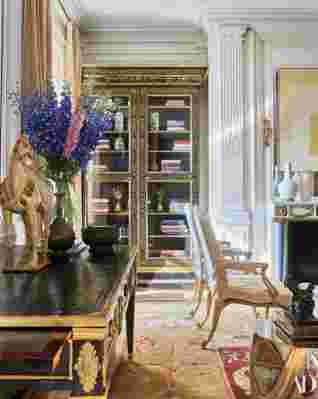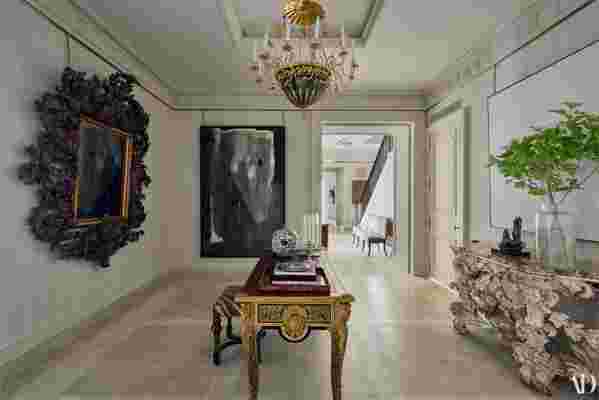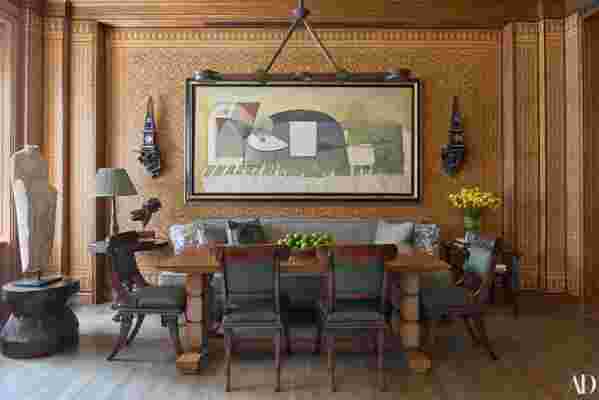In these challenging times, long-term relationships are hard to sustain. Los Angeles–based AD100 designer Michael S. Smith , renowned for his work at the White House for Barack and Michelle Obama and for many other A-list clients, has enjoyed a solid one with a certain couple who have been his clients for 25 years. The apartment that this pair purchased several years ago has been a lengthy undertaking, too.
The eight-bedroom duplex, atop an iconic 1920s Rosario Candela–designed building, was considered one of Manhattan’s ultimate trophy apartments. In fact, the residence had a big drawback—it was basically two separate apartments. Its previous owners, a business mogul and his wife, had bought the adjacent units in the late 1980s and combined them, but only in a rudimentary way. “They busted a hole in a wall, but the apartments were never properly integrated,” attests one of the new owners—the husband, a financier.

A view of the living room.
The mogul had been stymied—as were many prospective purchasers after his widow put it on the market—by a seemingly insurmountable obstacle: A grand staircase in the center of the footprint blocked complete consolidation.
“The key to the whole thing was taking out that staircase,” says the financier. “But who in New York thinks about taking out a staircase? You have to think outside the box.
“Of course, that’s what Michael does, along with [architect] Oscar [Shamamian],” he continues. “They just took the stair out and put another one over there. And, voilà.”
But maybe it was not quite so simple.
“Well, four and half years later. And some money,” the financier adds.
“Oscar and I did a huge victory lap when we figured out how we could fuse the apartments,” says Smith. “People in the past, I think, were held back because they were so enamored—as they should be—of original Candela architecture. But Oscar built this amazing new stair that changed everything and really added to the value of Candela’s design because it made everything work.”
Throughout the years-long odyssey, the couple didn’t flinch. “Most people don’t love the process as much as they do, and aren’t prepared to be as brave,” says Smith.Once the engineering hurdles were cleared, the most formidable challenge involved integrating the couple’s museum-quality collection of art and antiques, much of which has been displayed in the dozen or so residences that Smith has designed for them over the past quarter-century.
“A lot of things have followed them around from house to house. It’s a really personal group of objects,” says Smith. “Some things are super-precious and some things are really simple—picked up in a flea market or a souk in Morocco.”
The couple’s paintings collection is focused on Old Masters and modern masters, while their superlative furniture collection veers mostly to the 18th century, though it does include stellar 20th-century and contemporary pieces.
When you walk in, you immediately get a sense of who lives here,” says Smith. “It’s eclectic, but it all holds together.
“I love the 18th century, but an apartment done with everything from the 18th century is frozen in aspic,” says the financier. “We like combining that period with modern art and furniture.”
Busy as he is, it’s the husband here who parses over aesthetic matters with Smith. His wife, who’s an investor behind a thriving fashion brand, is happy to delegate these concerns to her spouse and Smith. (Their two adult children have left the nest.)
“I do the heavy lifting,” the husband explains. “Between [my wife and me], she’s the client and I’m the designer. She’s not going to go through 100 auction catalogs, but I like to. I’d rather spend three hours walking through the Rive Gauche; she’d rather not. In the end, I show her choices, and she picks, say, 15 things she likes.“Tramping around for art and antiques with Michael is probably my favorite leisure-time activity,” he continues. “We always have fun. It’s not like it’s work.”


When it comes to putting all these purchases together, the couple leaves it in Smith’s expert hands.
“He so knows what we want by now,” says the husband. “But it’s not really accurate to say he gives us what we want. Why should he give us what we want? We’re not design professionals. He gives us things we didn’t know we wanted. Sometimes he will keep showing me something I say no to. If I say no three times, then I know it must be great, and I say yes.
“In every room there is something discordant, that doesn’t belong—that’s fabulous,” he adds. “His stuff is not matchy-matchy.”
For Smith, the challenge was to bring harmony to this collection of spectacular but diverse objects.
“There are many high points, but not everything is at full volume. Overall, the apartment is serene and quiet, not jumpy. Things reveal themselves to you slowly,” says Smith.
On the fast track, Smith has two major auctions at Christie’s featuring contents of residences he designed: “Eaton Square,” in London, September 12, and “A Tale of Two Cities, New York and Los Angeles,” in New York, September 26. The designer has also created a new blog, The House on Mapleton Drive, to chronicle the major renovation of his primary residence in Los Angeles, which he shares with James Costos, the former U.S. ambassador to Spain, his life partner of the last 18 years. Clearly, Smith is one for long-term relationships.
